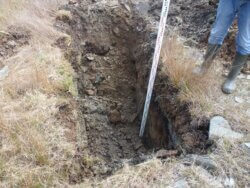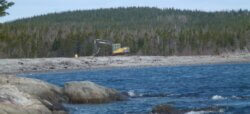When Hurricane Fiona came ashore in Nova Scotia on September 24th and proceeded up the coast to Prince Edward Island and Newfoundland, it caused considerable damage to nearby communities.
Port Hilford Bay, where the Whale Sanctuary site is located, is a sheltered area. But over the past two years of environmental assessments, starting with Hurricane Teddy in September 2020, we have been monitoring all kinds of weather and taking photos and video at two specific locations so we can see all the variations in wave heights and surges.
Taking these kinds of observations is just one of the many environmental site assessments that are essential to the viability of the sanctuary and to the safety of the whales and their caregivers who will live there.
Many of them are also required by law.
Over the last two years, these studies have included documenting water depths, testing the water chemistry, salinity, and temperature gradients, and studying currents, tides, waves and surges. (Check out this post for examples of some of them.)
We do this not only to understand the environment for the whales and the sanctuary infrastructure, but to provide data to government agencies for the many permits that are required for a project of this magnitude. Some of these data require documentation through every season over a two-year period.
Governmental requirements in Nova Scotia.
Development projects in Nova Scotia require various levels of environmental site assessment and the Whale Sanctuary Project is no exception. In addition, in the areas where we will be constructing our support buildings, we need to know the structural integrity of the land, the depth of the water table and, frankly, everything that could impact our building footprints and the work we will be doing on site.
Our test results have shown that we have good water quality.For a whale sanctuary, the health and welfare of the whales is the highest priority. So, our initial studies, starting in 2020 and continuing through every season, focused on water quality. Our water quality sampling in the bay and in areas where freshwater drains into the bay have been extensive, and our test results have shown that we have good water quality.
We’ve known since we selected Port Hilford Bay for the sanctuary site that the community of Wine Harbour was an area of historical gold mining from the 1880s to the 1930s. So initially, members of our team reviewed the publicly available data and the government records on where the gold mining was concentrated.

We engaged consultants to conduct an environmental site assessment.
Specifically, we wanted to know where gold mines shafts were located, where remnants of gold mine tailings remain on the 30 acres of sanctuary lands, and what impact, if any, these could have either on the soils or on the submerged soils in the waters where the sanctuary will be located.
To complete these analyses, we engaged consultants to conduct an environmental site assessment – an ESA II – on the 30 acres of land as well as on the submerged land within the sanctuary 100-acre footprint. The land-side work has been completed and has identified mine shafts that have been filled, others that remain unfilled, and analyzed soils in test pits dug throughout the property. The results of this work now enable us to move on to an ESA III to see whether there are any land-side areas that may require any site mitigation for our buildings.
Permits for permits
In preparing to take the 18 core samples of submerged soils (a core is similar in size to a 16 oz water bottle) our consultants were surprised to learn that a permit from the Department of Natural Resources & Renewables (DNRR) would be required for this work. We applied for the permit in April with our consultants assuming this would be a straightforward permit and that they could do their work in May or early summer. Unfortunately, it took almost five months, until late August, for DNRR to let us know that in advance of issuing the permit to take these 18 core samples, we would be required to undertake an Archeological Resource Impact Assessment (ARIA) as a part of First Nation consultation. We have now initiated the ARIA and will have to see how long that takes and when the permit for the 18 core samples can be issued.
The whale sanctuary is a first-of-its-kind project and there is no existing documentation that outlines all the necessary steps.(One might reasonably ask why we didn’t learn of this earlier. The answer is that the whale sanctuary is a first-of-its-kind project in North America and there is no existing documentation that would outline all the necessary steps. This is the case for us, and it is the case for the agencies that are required to oversee and permit each aspect of the project approval. This example demonstrates how complex and time-consuming the process is.)
Meanwhile, we have embarked on more detailed work on those areas where we already know there was historical gold mining. Our research to date indicates that that any contamination that may exist in these areas can be mitigated for our development purposes.
Geotechnical engineering
Other tests of soil, rock and sediment, known as geoengineering, include learning where and how best to anchor the net that will surround the sanctuary waters.

Our perimeter net will extend approximately one mile through the water, from Rocky Point and around the 100 acres of sanctuary water to the tip of Barachois Island. It will be a state-of-the-art structure that has to be anchored to the seabed and constructed in a way that can comfortably withstand hurricane-force winds and currents, as Nova Scotia experienced in Hurricane Fiona. (For more about the net and the structure that supports it, along with other diagrams, go here.)
Our local geotechnical engineers are working with net system designers to align the net systems design with local conditions based on the hydrodynamic model of the currents, water levels, wave action and sediment transport of the bay that we conducted in 2021 and with the LIDAR study conducted in 2022 to make a digital 3-D representation of the sea floor of the sanctuary.
When will all these studies be completed?
As a member of our Advisory Group, Steve Huxter, recently summed it up in a social media post:
“I’ve been the project manager for a wildlife research study, and a factor that takes time is the approval and permitting process through multiple stakeholders and regulatory networks, not the least of which are Municipal, District, County, Provincial and Federal (multiple ministries) governments. The support of the Port Hilford community and any First Nations stakeholders are equally important … Once submitted, the various ministries will come back with questions, and the back-and-forth with government agencies is seldom as timely as we would like. The data that is needed must be gathered through seasonal changes … Otherwise, the study lacks rigor and accuracy.”
As the first sanctuary of its kind anywhere in the world, this is a pioneering effort that began with a two-year search on both sides of the North American continent for the most suitable location. Everything we learn, as we complete each stage of the project, is not only essential to the construction and operation of this sanctuary; it will also act as a blueprint to inform the creation of other much-needed sanctuaries for captive cetaceans throughout the world.
So, while our objective is still to welcome whales by the end of 2023, we all need to bear in mind that in any new, pioneering effort, there are always considerations that require adjusting our schedule as we go along (as we have had to do through two years of covid-related delays).
The view ahead
None of this work can happen soon enough for the whales who are languishing in concrete tanks and are subject to intolerable conditions.
Yet it is essential to get everything right for the health and safety of those very whales when they are introduced to an entirely new life.
It is also the law.
Earlier this year, we received and executed the Offer of Lease from the Department of Natural Resources & Renewables, which makes available to the sanctuary a total water space of 200 acres. This includes 100-plus acres for the whales, Barachois Island, a security zone around the sanctuary, and the space needed for the anchoring system. The lease requires that all permits be issued, and that various terms and conditions be met.
This is also an expensive project, and one that is only possible thanks to our generous supporters who make possible each stage of the site development work.
We greatly appreciate the grants we have received to purchase the sanctuary lands, the recent pledge of $5 million that will enable us to begin construction as soon as permitting is complete, and the support of the many individuals who donate to the Whale Sanctuary Project.
Thank you for being part of the Whale Sanctuary Project, and we look forward, as you do, to welcoming the first whales to their new life.